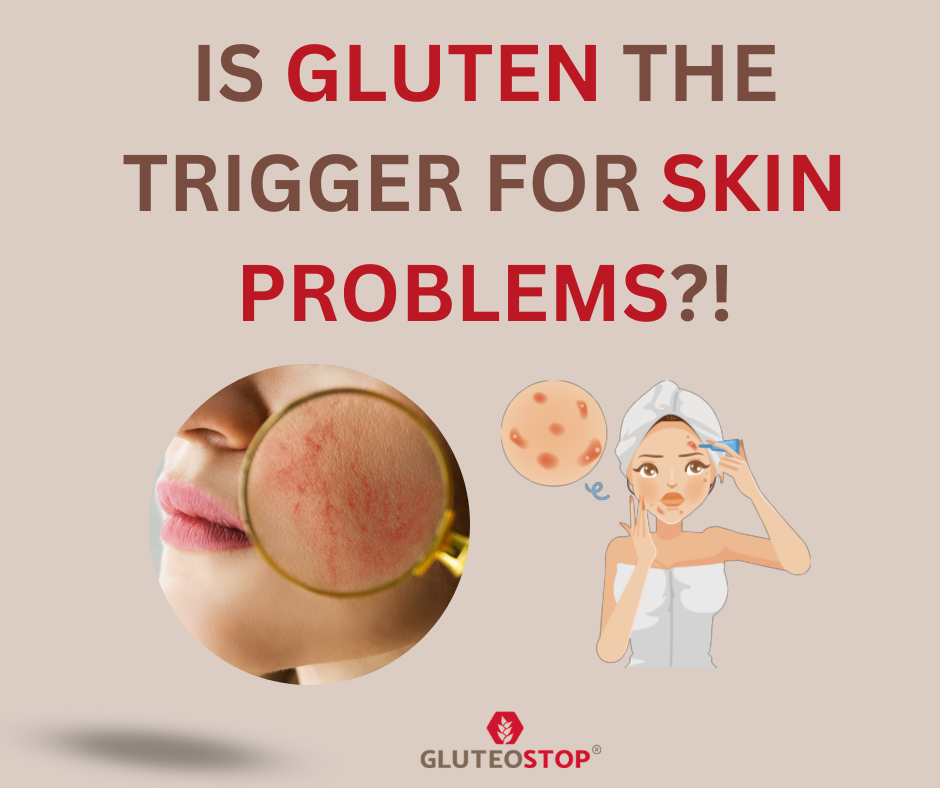Gluten sensitivity (NCGS) and celiac disease can affect much more than just the digestive system - they can also affect the skin, in the form of various skin conditions.
About 15 to 25% of people with celiac disease suffer from dermatitis herpetiformis, a rash that is considered a skin manifestation of celiac disease. However, this is far from the only skin problem that people with celiac disease and non-celiac gluten sensitivity (NCGS) may have. 29 % of 486
Patients with suspected gluten sensitivity (NCGS) who participated in a study showed rash and 18% of them had dermatitis that was not clearly diagnosed.1
In addition to dermatitis herpetiformis, people with celiac disease may also suffer from eczema, psoriasis, acne, chronic dry skin, hives and alopecia areata. For certain reasons, celiac disease sufferers are more likely to be affected by these skin problems than the general population.
Research has not yet focused as much on the skin conditions associated with NCGS, but numerous reports suggest that some gluten-sensitive people who are not affected by celiac disease have significantly fewer skin problems when they avoid gluten.
Although there is currently little clear medical evidence that eating gluten actually causes the skin conditions mentioned above, in many cases sufferers have been able to achieve significant improvement by following a gluten-free diet. The skin problems associated with celiac disease range from itchy rashes to hair loss.
Here is a summary of the most common skin conditions currently associated with celiac disease:
Dermatitis Herpetiformis
Dermatitis Herpetiformis is a skin rash caused by the consumption of gluten. According to sufferers, it is one of the most itchy rashes ever experienced. The lesions can not only itch, but also sting and burn. The lesions can occur anywhere on the body, but are most common on the elbows, knees, buttocks, lower back, head and neck.
If you have dermatitis herpetiformis, it is assumed that you are also affected by celiac disease. This should definitely be confirmed by a blood test if the celiac diagnosis is still pending.
Psoriasis
Psoriasis is an inflammatory, non-contagious disease. It is mainly characterized by reddish, scaly skin lesions that can be itchy. Several studies show that there is a close connection between psoriasis and the consumption of gluten.
People with psoriasis often have high levels of antibodies to gluten in their blood, suggesting that they are sensitive to gluten in their diet, even if they have not been diagnosed with celiac disease. It is not clear whether gluten causes psoriasis, or whether people with psoriasis are also more likely to have celiac disease, or vice versa
However, some reports suggest that psoriasis patients' skin symptoms improve dramatically when they adopt a gluten-free diet, regardless of whether they have been diagnosed with celiac disease.
ECZEMA
Eczema, another itchy skin rash, causes scaly, whitish patches on the skin. Eczema is most common in children, but adults can also have this skin condition. Although the primary treatment for eczema is topical glucocorticosteroids (cortisone), there is some evidence that eczema in some people is related to an undiagnosed celiac disease.4 In these people, a necessary, strict gluten-free diet may help treat their skin condition.
![]()
ACNE
Although there is no published medical research linking
celiac disease or gluten sensitivity and the common skin condition of teenage acne, many people with acne have reported relief from their skin problems when they changed their diet to gluten-free. Currently, there is no scientific evidence that gluten causes acne, although many patients report that their acne disappeared once they gave up gluten. This is understandable since gluten is pro-inflammatory and acne is often predominantly inflammatory. Additionally, a low-carbohydrate diet is advised.
![]()
Chronic Urticaria
A 2005 study found that 5% of children with chronic urticaria (known colloquially as hives) also had celiac disease. After the children in the study were diagnosed with celiac disease and introduced to a gluten-free diet, chronic urticaria disappeared in all of them within five to ten weeks.
Dry skin
Many people with celiac disease and gluten sensitivity suffer from very dry skin. In some cases, this improves after they change their diet and avoid foods containing gluten. Again, it is not clear if the disease is the cause of the dry skin, but some doctors suspect that a possible nutrient deficiency due to malabsorption in untreated celiac disease, could be the cause.
Sources data
1) Volta U, Bardella MT, Calabrò A, Troncone R, Corazza GR; Study Group for Non-Celiac Gluten Sensitivity. An Italian prospective multicenter survey on patients suspected of having non-celiac gluten sensitivity. BMC Med. 2014 May 23;12:85.
2) Antiga E, Maglie R, Quintarelli L, et al. Dermatitis herpetiformis: novel perspectives. Front Immunol. 2019;10:1290.
3) Bhatia BK, Millsop JW, Debbaneh M, Koo J, Linos E, Liao W. Diet and psoriasis, part II: celiac disease and role of a gluten-free diet. J Am Acad Dermatol. 2014;71(2):350-8.
4) Bonciolini V, Bianchi B, Del Bianco E, Verdelli A, Caproni M. Cutaneous manifestations of non-celiac gluten sensitivity: clinical histological and immunopathological features. Nutrients. 2015 Sep 15;7(9):7798-805.
5) Caminiti L, et al. Chronic urticaria and associated coeliac disease in children: a case-control study. Pediatr Allergy Immunol. 2005 Aug;16(5):428-32.
